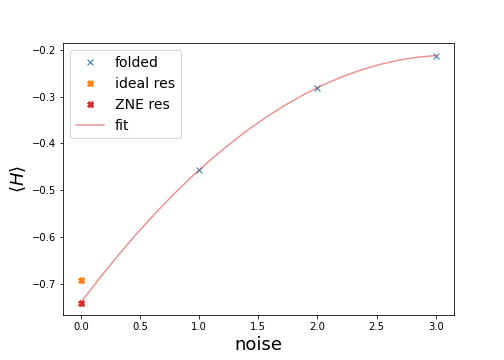qml.transforms.fold_global¶
- fold_global(tape, scale_factor)[source]¶
Differentiable circuit folding of the global unitary
circuit.For a unitary circuit \(U = L_d .. L_1\), where \(L_i\) can be either a gate or layer,
fold_globalconstructs\[\text{fold_global}(U) = U (U^\dagger U)^n (L^\dagger_d L^\dagger_{d-1} .. L^\dagger_s) (L_s .. L_d)\]where \(n = \lfloor (\lambda - 1)/2 \rfloor\) and \(s = \lfloor \left(\lambda - 1 \right) (d/2) \rfloor\) are determined via the
scale_factor\(=\lambda\). The purpose of folding is to artificially increase the noise for zero noise extrapolation, seemitigate_with_zne().- Parameters:
tape (QNode or QuantumTape) – the quantum circuit to be folded
scale_factor (float) – Scale factor \(\lambda\) determining \(n\) and \(s\)
- Returns:
The folded circuit as described in
qml.transform.- Return type:
qnode (QNode) or tuple[List[QuantumTape], function]
See also
mitigate_with_zne(); This function is analogous to the implementation inmitiqmitiq.zne.scaling.fold_global.Note
This method no longer decomposes the circuit as part of the folding procedure. Users are encouraged to use
decompose()to expand the circuit into a target gateset before using this transform.Example
Let us look at the following circuit.
x = np.arange(6) @qml.qnode(dev) def circuit(x): qml.RX(x[0], wires=0) qml.RY(x[1], wires=1) qml.RZ(x[2], wires=2) qml.CNOT(wires=(0,1)) qml.CNOT(wires=(1,2)) qml.RX(x[3], wires=0) qml.RY(x[4], wires=1) qml.RZ(x[5], wires=2) return qml.expval(qml.Z(0) @ qml.Z(1) @ qml.Z(2))
Setting
scale_factor=1does not affect the circuit:>>> folded = qml.transforms.fold_global(circuit, 1) >>> print(qml.draw(folded)(x)) 0: ──RX(0.0)─╭●──RX(3.0)──────────┤ ╭<Z@Z@Z> 1: ──RY(1.0)─╰X─╭●────────RY(4.0)─┤ ├<Z@Z@Z> 2: ──RZ(2.0)────╰X────────RZ(5.0)─┤ ╰<Z@Z@Z>
Setting
scale_factor=2results in the partially folded circuit \(U (L^\dagger_d L^\dagger_{d-1} .. L^\dagger_s) (L_s .. L_d)\) with \(s = \lfloor \left(1 \mod 2 \right) d/2 \rfloor = 4\) since the circuit is composed of \(d=8\) gates.>>> folded = qml.transforms.fold_global(circuit, 2) >>> print(qml.draw(folded)(x)) 0: ──RX(0.0)─╭●──RX(3.0)──RX(3.0)†──RX(3.0)──────────────────┤ ╭<Z@Z@Z> 1: ──RY(1.0)─╰X─╭●────────RY(4.0)───RY(4.0)†─╭●──╭●──RY(4.0)─┤ ├<Z@Z@Z> 2: ──RZ(2.0)────╰X────────RZ(5.0)───RZ(5.0)†─╰X†─╰X──RZ(5.0)─┤ ╰<Z@Z@Z>
Setting
scale_factor=3results in the folded circuit \(U (U^\dagger U)\).>>> folded = qml.transforms.fold_global(circuit, 3) >>> print(qml.draw(folded)(x)) 0: ──RX(0.0)─╭●──RX(3.0)──RX(3.0)†───────────────╭●─────────RX(0.0)†──RX(0.0)─╭●──RX(3.0)──────────┤╭<Z@Z@Z> 1: ──RY(1.0)─╰X─╭●────────RY(4.0)───RY(4.0)†─╭●──╰X†────────RY(1.0)†──RY(1.0)─╰X─╭●────────RY(4.0)─┤├<Z@Z@Z> 2: ──RZ(2.0)────╰X────────RZ(5.0)───RZ(5.0)†─╰X†──RZ(2.0)†──RZ(2.0)──────────────╰X────────RZ(5.0)─┤╰<Z@Z@Z>
Note
Circuits are treated as lists of operations. Since the ordering of that list is ambiguous, so is its folding. This can be seen exemplarily for two equivalent unitaries \(U1 = X(0) Y(0) X(1) Y(1)\) and \(U2 = X(0) X(1) Y(0) Y(1)\). The folded circuits according to
scale_factor=2would be \(U1 (X(0) Y(0) Y(0) X(0))\) and \(U2 (X(0) X(1) X(1) X(0))\), respectively. So even though \(U1\) and \(U2\) are describing the same quantum circuit, the ambiguity in their ordering as a list yields two differently folded circuits.Usage Details
The main purpose of folding is for zero noise extrapolation (ZNE). PennyLane provides a differentiable transform
mitigate_with_zne()that allows you to perform ZNE as a black box. If you want more control and see the extrapolation, you can follow the logic of the following example.We start by setting up a noisy device using the mixed state simulator and a noise channel.
n_wires = 4 # Describe noise noise_gate = qml.DepolarizingChannel noise_strength = 0.05 # Load devices dev_ideal = qml.device("default.mixed", wires=n_wires) dev_noisy = qml.transforms.insert(noise_gate, noise_strength)(dev_ideal) x = np.arange(6) H = 1.*qml.X(0) @ qml.X(1) + 1.*qml.X(1) @ qml.X(2) def circuit(x): qml.RY(x[0], wires=0) qml.RY(x[1], wires=1) qml.RY(x[2], wires=2) qml.CNOT(wires=(0,1)) qml.CNOT(wires=(1,2)) qml.RY(x[3], wires=0) qml.RY(x[4], wires=1) qml.RY(x[5], wires=2) return qml.expval(H) qnode_ideal = qml.QNode(circuit, dev_ideal) qnode_noisy = qml.QNode(circuit, dev_noisy)
We can then create folded versions of the noisy qnode and execute them for different scaling factors.
>>> scale_factors = [1., 2., 3.] >>> folded_res = [qml.transforms.fold_global(qnode_noisy, lambda_)(x) for lambda_ in scale_factors]
We want to later compare the ZNE with the ideal result.
>>> ideal_res = qnode_ideal(x)
ZNE is, as the name suggests, an extrapolation in the noise to zero. The underlyding assumption is that the level of noise is proportional to the scaling factor by artificially increasing the circuit depth. We can perform a polynomial fit using
numpyfunctions. Note that internally inmitigate_with_zne()a differentiable polynomial fit functionpoly_extrapolate()is used.>>> # coefficients are ordered like coeffs[0] * x**2 + coeffs[1] * x + coeffs[0] >>> coeffs = np.polyfit(scale_factors, folded_res, 2) >>> zne_res = coeffs[-1]
We used a polynomial fit of
order=2. Usingorder=len(scale_factors) -1is also referred to as Richardson extrapolation and implemented inrichardson_extrapolate(). We can now visualize our fit to see how close we get to the ideal result with this mitigation technique.x_fit = np.linspace(0, 3, 20) y_fit = np.poly1d(coeffs)(x_fit) plt.plot(scale_factors, folded_res, "x--", label="folded") plt.plot(0, ideal_res, "X", label="ideal res") plt.plot(0, zne_res, "X", label="ZNE res", color="tab:red") plt.plot(x_fit, y_fit, label="fit", color="tab:red", alpha=0.5) plt.legend()
